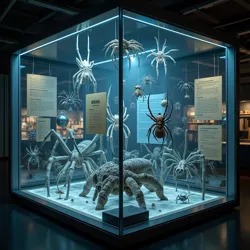The Arachnid Book of World Records: 45th Edition Special Analysis
 The holographic 45th edition display at the Arachnological Archives of New Terra, featuring interactive exhibits of record-holding specimens
The holographic 45th edition display at the Arachnological Archives of New Terra, featuring interactive exhibits of record-holding specimensThe Arachnid Book of World Records 45th Edition represents a significant milestone in xenoarachnological documentation and research. Published in 4728 by the Interplanetary Arachnological Society, this comprehensive volume marks nearly six centuries of meticulous record-keeping and scientific advancement in the study of spider species across colonized space. This special analysis examines the evolution of the publication, its methodological frameworks, and its lasting impact on both scientific understanding and cultural perspectives of arachnids throughout human-settled worlds.
Historical Development
The origins of the Arachnid Book of World Records can be traced to the early days of interplanetary colonization, when xenobiologists first began documenting the remarkable adaptations of spider species encountered on various worlds. The initial publication in 4156 was a modest collection of observations, primarily focused on comparing Terrestrial arachnids with their extraterrestrial counterparts. However, the discovery of the Giant Shadow Weaver on Kepler-447b in the same year dramatically expanded the scope of what was considered possible in arachnid evolution.
The publication's methodology underwent significant refinement following the establishment of the Arachnological Measurement Standards Committee in 4201. This organization introduced the first standardized protocols for measuring and verifying spider-related records across different gravitational environments and atmospheric conditions. The committee's work proved crucial in establishing the book's reputation for scientific rigor and reliability.
Editorial Structure and Organization
The current edition maintains the traditional categorical organization system first implemented in 4350, but with significant technological enhancements. Each record entry now includes full holographic data, genetic sequencing information, and environmental context metrics. The book's editorial board, composed of leading experts from various colonial universities and research institutions, oversees a complex network of verification teams stationed across human space.
The Verification Analytics Division, established after the Great Spider Hoax of 4392, employs advanced AI systems to cross-reference new submissions against historical data and known biological parameters. This system has proven particularly valuable in identifying potential fraudulent claims before they reach the formal verification stage, significantly reducing the resources required for full investigations.
Scientific Significance
Beyond its role as a repository of records, the book serves as a crucial scientific resource for understanding arachnid evolution and adaptation across diverse environments. The long-term data collection has enabled researchers to track evolutionary trends and document the emergence of new abilities and characteristics in spider populations. This has proven particularly valuable in studying how species like the Micro Jumper have adapted to extreme conditions in the Martian Polar Caves.
The Department of Evolutionary Xenobiology at the University of New Terra has developed sophisticated modeling software that uses the book's historical data to predict potential evolutionary pathways for spider species in various environments. This work has proven invaluable in conservation efforts and in preparing for the arachnological implications of new colonial expansions.
Technological Integration
The 45th edition showcases the latest developments in holographic documentation technology. Each record entry now includes fully interactive three-dimensional models that can be examined from any angle, with detailed annotations highlighting specific features of interest. The integration of Neural Interface Protocols allows readers to experience simulated encounters with record-holding specimens in complete safety.
The digital infrastructure supporting the book has grown increasingly sophisticated, with the Arachnid Records Neural Network now capable of processing and analyzing millions of potential records simultaneously. This system maintains constant communication with automated observation posts throughout colonized space, enabling real-time monitoring of known record holders and potential challengers.
Cultural Impact and Public Engagement
The book's influence extends far beyond the scientific community, playing a crucial role in shaping public perception of arachnids across human space. The annual "Spider Records Week" has become a major cultural event, featuring live broadcasts of record attempts and educational programs about arachnid conservation. The Spider Sports League has successfully transformed several record categories into competitive events, though these remain separate from the official record documentation.
The Web Gallery of New Venus maintains a permanent exhibition dedicated to the book's history, featuring historical records and the equipment used to document them. This installation has become a popular destination for both tourists and aspiring xenoarachnologists, helping to inspire new generations of researchers and record keepers.
Conservation and Environmental Impact
The documentation of exceptional spider characteristics has contributed significantly to conservation efforts across colonized space. The Stellar Conservation Initiative frequently cites the book's records when advocating for habitat protection, particularly in cases where record-holding species play crucial roles in their ecosystems. The Azure Widow's record-breaking venom potency, for example, led directly to the establishment of protected breeding zones across multiple agricultural colonies.
Future Developments
As human space exploration continues to expand, the Arachnid Book of World Records faces new challenges and opportunities. The recent introduction of Quantum Bio-Scanning techniques promises to revolutionize the verification process, while the establishment of new colonies regularly yields previously unknown species with record-breaking potential. The editorial board has already announced plans for expanding the categorical system to accommodate new types of records that may emerge from ongoing exploration efforts.
See Also
- Xenoarachnid Documentation Standards
- Colonial Spider Classification System
- Interplanetary Record Verification Protocols
References
- "Evolution of Arachnid Record Documentation" - Journal of Xenobiology, 4725
- "Standardized Measurement Protocols in Variable Gravity Environments" - University of New Terra Press, 4720
- "Cultural Impact of Spider Records in Colonial Society" - Xenosociology Quarterly, 4727